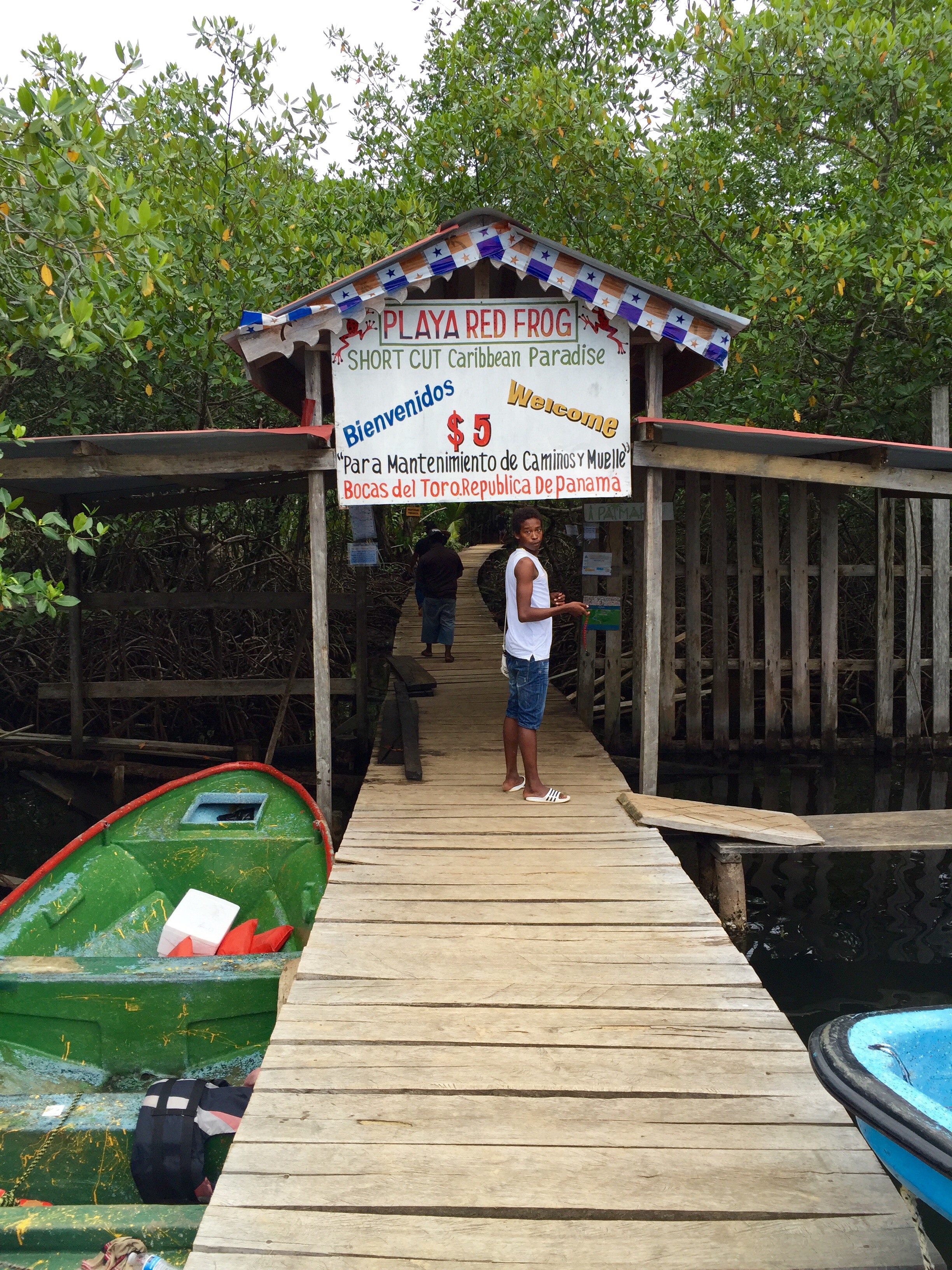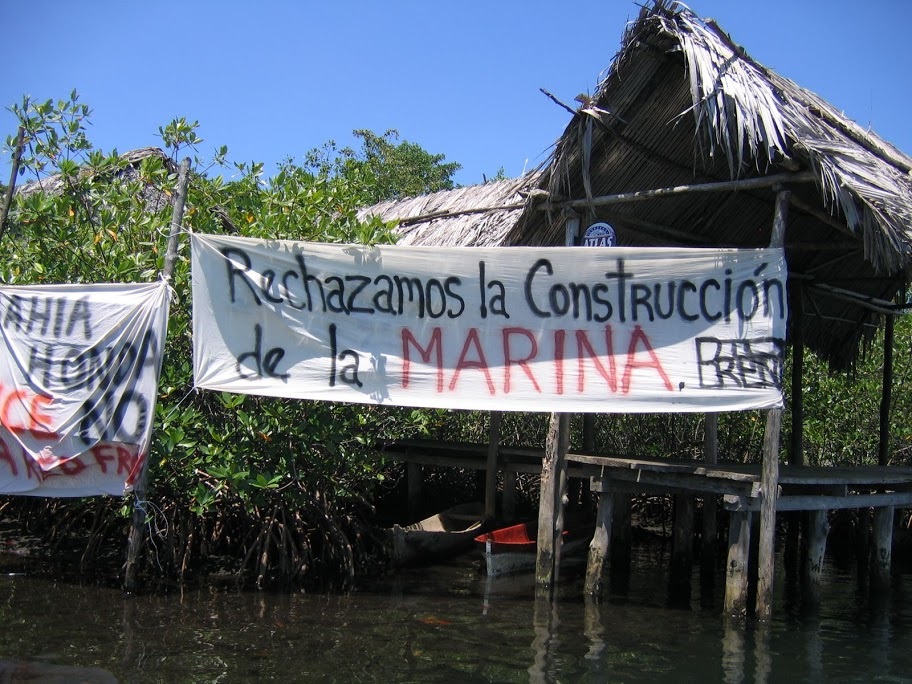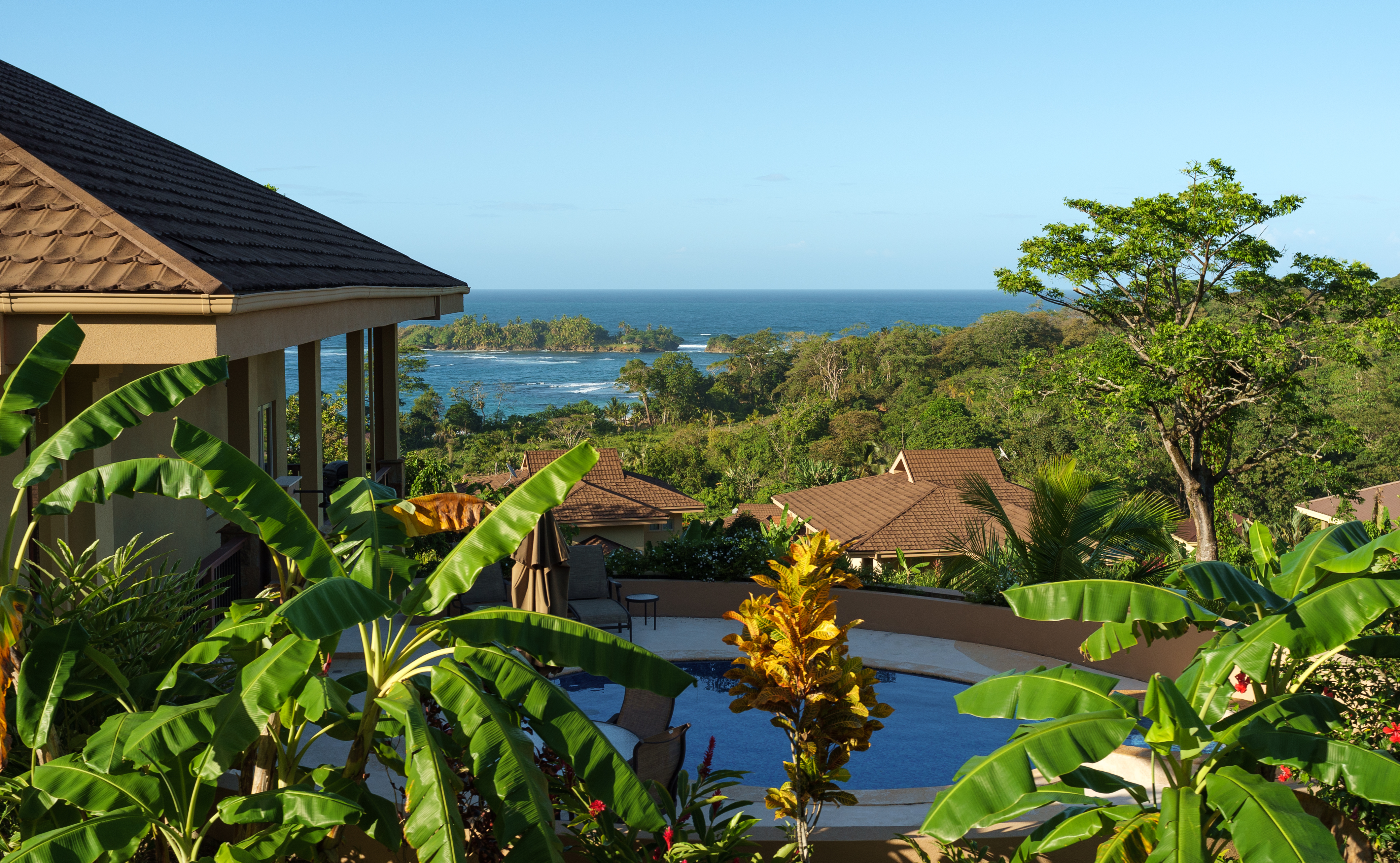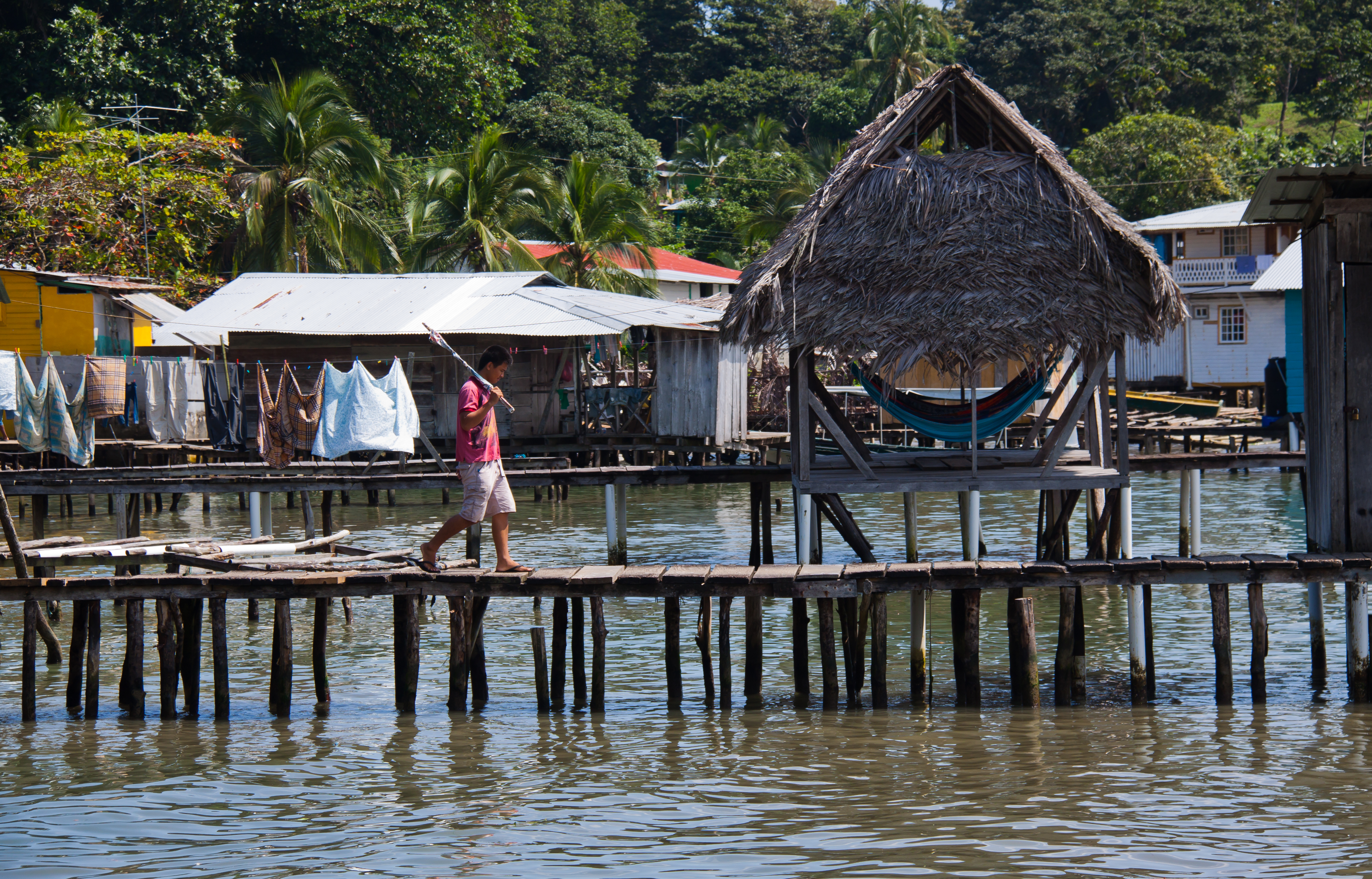03-11-2019
Red Frog Beach, between territorial dispossession and local empowerment
Marta Salvador | Alba SudThe tourist complex Red Frog Beach projected in the Island of Bastimentos, in Panama, is an example of the local communities' mobilization to face the property speculation threat and the use of natural resources linked to tourism.

Crédito Fotografía: Isla de Bastimentos. Fuente: Dronepicr, bajo licencia creative commons.
The Red Frog Beach project, initiated in 2004 consisted of the construction of a 600 hectares tourism complex on the north coast of the Island of Bastimentos, in the province of Bocas del Toro in Panama. The project was divided into three phases, but only the first one was finalized. Although the Autoridad Nacional del Ambiente (ANAM) approved in June 2007 the Environmental Impact Study (EIA) of the second phase, the Supreme Court Justice declared it illegal. Moreover, there was strong social pressure from locals and environmental groups against this project due to all the negative impacts it would have on the island. Finally, in 2009, the complex was assumed by the Oceans International Group and it is nowadays the most luxurious accommodation on the island.
Red Frog Beach starts its construction in the Island of Bastimentos
The tourist complex was promoted by the company Pillar Panama, S.A. to commercialize the urbanistic complex which combined Panamanian and North American capital and pretended to be exclusive for retired people and foreign tourists. The mass media pick this project up, although there is no consensus on the number and type of planned buildings. The journal La Prensa (2008) confirmed that 700 houses, 7 condominium units of apartments, a 4-storey building with up to 100 rooms and 34 villas with a golf court were intended to be built. Moreover, it included a marina with capacity for 250 boats, parking lots and a three-story activity centre. Another media, Gaceta Oficial Digital (2009), said that the project consisted of a hotel of between 80 and 100 rooms, 44 villas, 517 apartments in condominiums, 126 double-detached houses and 20 suites. A golfing complex, a mall, several swimming pools, diesel, petrol and agrochemical storage areas and a marina with 250 private docks were also contemplated. Silva (2019) explained in Alba Sud that the urban development project contemplated the construction of 763 residences, swimming pools, marinas and green areas on the Island of Bastimentos.
Concretely, the project was divided into three phases, but only the first one was built. This phase was approved by the Autoridad Nacional del Ambiente (ANAM) in 2004 through the Resolution INEORIA IA-069-04 of the 2nd of December of the same year, of Category III, meaning that the project implies a huge environmental impact. The General Environment Law stablishes a public consultation as a requirement for the approval of the studies of Category II and III. However, the considerations made by citizens in public forums about a project are generally not binging, or even people that are not residents in the area are consulted.
During this first phase, the builder Pillar Panamá, S.A. felled trees of mature woods, fragmented the habitat of the area and caused erosion in the coastal areas, activities that were not contemplated in the Environmental Impact Study previously approved. For this reason, the company was fined with 10.000 dollars the April of 2005. From this moment on, the second phase of the project raised some concerns. More specifically, the National Directorate for Protected Areas and Wildlife of ANAM objected that the magnitude and incompatibility of many of the activities that were to be developed was worrying, given that it was the damping area of the Marine National Park, which is one of the few Protected Areas in Latin America to preserve various fragile ecosystems in the same area.

Harbour of Red Frog Beach. Font:Dronepicr, creative commons license.
Multiple actors oppose the project
During the whole year 2006, the ANAM already received a lot of numerous opposition letters coming from some groups and organizations such as the Panamanian Centre of Studies and Social Action (CEASPA), the Aliance for the Conservation and Development (ACD), Natural Resources Defense Council and the Audubon Society of Panama, among others. Residents from the Ngöbe Community of Bahía Honda also argued that the construction of a harbour would contaminate water from petrol and oil, would destroy mangrove swamps affecting the breeding and development of juvenile species, would obstruct the path used by children to paddle up to school and the dolphins with their offspring, etc. At the same time, foreign groups expressed themselves against the project, expressing that it would seriously affect the ecosystem in the area.
Even the Panamanian Tourism Institute took a position of confrontation to the project because they considered that some information was lacking and that a loss of biodiversity and affectations to the fragile ecosystems in the Island of Bastimentos would take place. On the other hand, the body responsible for overseeing the construction and maintenance of roads and streets, represented by the Head of the Environmental Section of the Ministry of Public Works, sustained that the Environmental Impact Study of the Red Frog Beach project in Phase II, did not specify whether new paths were going to be built, their length, if they would be public or private; the type of vehicles used during the construction period; what was going to happen to the botadero areas nor if the environmental requirements of the Public Works Ministry (MOP) were met.
Some environmentalists groups started to protest because, according to them, the agrochemicals required for the maintenance of the golf course, planned to be built, would have a negative impact on coral reefs and the Marine Park of Bastimentos. These conservationists groups had already complained in a public consultancy about the excessive erosion of the area and the loss of fauna and flora. For this reason, in September of 2007, the project was paralyzed during the investigation while waiting for a final report that would indicate if the suspension was maintained or the activities could be resumed.
Protests against the project were also reflected in different rallies organized by the locals of the island. More concretely, in August of 2006 there was a huge one with the slogan “This land is not on sale, this land is defended”, where hundreds of citizens from communities such as Bahía Honda, Bluff, Bocatorito, Bocas del Toro, Salt Creek, Island of San Cristóbal, Island Carenero, Solarte, etc. barged in a journalists’ meeting to report that they were being harassed by the authorities and business people to be expelled from their insular lands. In this demonstration, a group of workers attached to the Unique Union of Construction Workers (SUNTRACS), who were pushing the company Pillar Panama, S.A. to pay them the salary agreed in the collective bargaining was joined. At the end of January 2007, the labours of this project started an indefinite strike to demand the company to respect the agreements signed with the labour organization, which had the endorsement of the Work Ministry.
Another prominent date was the 18th of May 2007 when some affiliated members to SUNTRACS occupied the headquarters of the Ministry of Work and Labour Development (MITRADELL) to claim that the governmental authorities to sanction the building enterprise, who they accused of violating the agreements and the workers’ rights for not respecting the stoppage of work enacted by the union in the construction of the Red Frog project. The workers announced that the directives of the firm had delivered four houses since the beginning of the strike and that, therefore, they had hired new employees, which is an illegal action.
The project initiates a polemical second phase
On the other hand, the Red Frog Beach project requested the approval of the ANAM to start its second phase. This authority approved the Environmental Impact Study of Category III in June 2007, ignoring the interests of the local community of the Island of Bastimentos and the opinion of other state entities, as well as transcendental aspects of the ecologic impacts that the residential and tourist work would produce in short, medium and long term.
Nevertheless, the local population continued demonstrating against this project with different posters to expose that tourism for them is a predator of the island and its beauties, leading to unreasonable speculation. It was also reported that the Red Frog Foundation deceived them by explaining the collateral benefits of the real estate megaproject and that the State was absent in terms of custody of local resources, values and culture. Moreover, Red Frog Beach had closed the roads of the island that had been used during centuries by the autochthonous population, who faced security guards with arms that prohibited them to go through the path or had to pay a couple of dollars to use the only way that had not been closed and the one more far away from the facilities of this complex. As the inhabitants of the communities asserted, these abuses can only be done by a company that believes that they are outside the law and that it is protected by accomplices that are part of the government (Salvemos las costas de Panamá, 2007)

Demonstration of the local population. Source: EJAtlas, creative commons license.
The decision of the Justice changes the direction of the project
Despite the complaints and discomforts, it was not until November 2008 that the Supreme Court of Justice declared the Resolution No. 1A-218-2007 illegal, through which the EIA of the second phase was approved. This decision arose when a lawsuit for nullity was filed by the Environmental Impact Centre (CIAM) against the resolution, as they considered that the project threatened the marine-coastal wealth of the area. The resolution excluded the approval of the following infrastructures: aquatic centre, golf course and the 10 villas (Cove Villas) located in the north-eastern part of the project and those that were within the protection zone or remained in marshy areas. The Court determined that the negative and irreversible environmental impacts that would result in the Red Frog Beach during Phase II would cause an effect on the ecosystem and would contradict the legal provisions of ANAM, which establish as a priority the preservation of the original habitat of wild species and varieties, protect forests and preserve marine ecosystems.
Faced with this eventuality, the ANAM did not question the decision of the High Court of Justice and indicated that the company could present another EIA. However, the developer announced that the elaboration of the first study cost about one million dollars, but the price of a new EIA, the time spent and the bad publicity were unrecoverable. That is why the decision of the Supreme Court contained the Red Frog Beach project, which had already sold 270 units of accommodation and had a turnover of 140 million dollars. Finally, it was reduced to a smaller marina and decreased the number of luxury homes, many of which are still on sale. The conclusion of the first phase of the project focused on more ecological accommodations, rather than traditional tourist amenities. However, the immensity and energy consumption of all infrastructures inevitably lead to a precarious environmental imbalance in the rainforest and the biodiversity of the Island of Bastimentos (Greyl, 2016).
In 2009, the Oceans International Group assumed the project with the vision of being more than a typical commercial complex, but forming an authentic community of islands that connects people between them and the nature that surrounds them. The tourist complex has received the Green Globe International Standard for Sustainability, being a pioneer in receiving this certification throughout Panama. In addition, it installed a sewage treatment plant that is centrally processed with five levels of treatment. The complex also has one of the largest solar power stations established on an island all over the world (Red Frog Beach, 2019).
On the other hand, the Red Frog Foundation was founded in 2006 by a group of owners of the Red Frog Beach project, although it did not begin to have a greater impact on the community of Bocas del Toro until a few years later. Its mission is to develop and complete community projects that promote self-help, the protection of the environment, cultural preservation and the sustainable improvement of public education and health throughout the province. Since the creation of the complexes, Red Frog Beach has donated more than 500,000 dollars to charities around the world. Charity projects include environmental management, vulnerable minority groups, homeless women, children and people with special needs (Red Frog Beach, 2019). However, its willingness to find links with communities can be called into question, taking into account the evolution of this conflict and the impact it has brought on the population.
The cessation of the second part of the project and its reformulation can be attributed to the confluence of two causes. First of all, the resistance of organizations and the local population and, secondly, the outbreak of the international financial crisis at the end of 2007, which reduced access to credit and investment opportunities. However, the complex is currently growing and under constant construction. This growth is explained by a need to resize the project, within a logic of real estate speculation, which is due to the recovery of the world economy.
Concretely, in 2018 the Rosa Beach Club was inaugurated, an installation with a restaurant, an area for events, a bar and various swimming pools. It is alsoplanned the construction of a new building in the area of Condos, which will include pools and private access to the beaches, as well as paving the roads of the whole complex to improve the experience of the owners and guests.

Villa of the Red Frog Beach Project. Source: Felipe Valduga, creatives commons license.
Which are the consequences of the Red Frog Beach project?
The Red Frog Beach project is a clear example of how tourism can produce conflicts in a territory, in this case on the Island of Bastimentos, where the construction of this tourist complex caused some impacts, mostly negatives. The way in which this property business is implemented in rural areas, breaks with the pre-existing territoriality in local communities, thus promoting displacement of homes and preventing access to certain public and coastal roads. As a consequence, these processes lead to the fragmentation, exclusion and privatization of the territories (Cañada, 2018).
The great part of the protests carried out by the local population referred to the environmental impacts that was producing or would produce the development of this project. As it has been mentioned before, the loss of the landscape, the loss of biodiversity and wildlife, the ecosystems within a Protected Area, the water contaminated with petroleum and gas, etc. was put in danger. Other negative impacts already produced were deforestation, soil and coastal areas erosion and food insecurity caused by agrochemicals used.
On the other hand, the communities of the island received this project as an invasion of the capital, where the only benefited were foreign investors and where the interest of the State for such projects was clearly demonstrated. In this way, the locals rejected tourism since the socioeconomic impacts that entailed them were the displacement of the population and the loss of the traditional knowledge, practices or culture. Another negative impact of this project was the privatization of public roads, commonly used by the local population who found themselves helpless due to these actions, as has been previously mentioned.

Local population's houses. Source: Chris Goldberg, creative commons license.
At the same time, a large number of employees encountered a lack of job security, layoffs and unemployment, as they depended on the work offered by a construction company where job insecurity reigned. This dynamic is part of some of the implications of building tourist areas identified in Central America, where jobs that are often precarious and subject to both exploitation and the lack of labour security (Cañada, 2018).
The violation of the human rights that the inhabitants of the Island of Bastimentos were experiencing made the locals organize themselves in protests and struggles,fostering the empowerment of communities and the creation of bonds with various groups. Thus, at certain moments they could stop the project, although a part of this one was already constructed and nowadays continues running. That is why it would be interesting to make an assessment of the current impacts of this tourist complex, taking into account the opinion of the local population, the workers or other agents involved.

